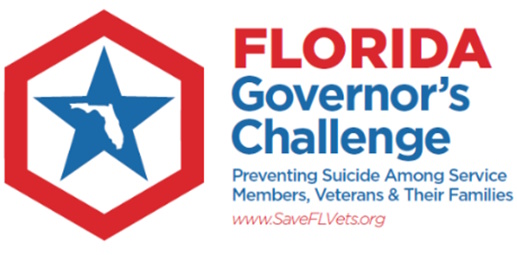It's a New Day in Public Health.
The Florida Department of Health works to protect, promote, and improve the health of all people in Florida through integrated state, county, and community efforts.
Veteran Suicide Prevention
Violence and Injury Prevention Section
- 850-245-4455
-
Mailing Address
4052 Bald Cypress Way, Bin A13
Tallahassee, FL 32399-1722
If you are feeling suicidal or in emotional distress:
Please call or text the Suicide Prevention Lifeline at 988 or reach out through chat by visiting www.988lifeline.org/chat/.
Veterans can call 988 and press 1.

Public Health Approach to Veteran Suicide Prevention
Incorporating the CDC’s Preventing Suicide: A Technical Package of Policy, Programs and Practices, taking a comprehensive approach to suicide prevention requires coordinating public health, healthcare, jobs and economic development, education, housing and other sectors. By joining multiple sectors, an upstream approach to prevention, as well as responding to people in crisis and connecting them to services and support is possible. To do so, the Department works to follow a series of steps together with our partners and programs.
Step 1: Veteran Suicide PreventionStep 2: Veteran Risk and Protective Factors
Step 3: Veteran Suicide Prevention Strategies
Step 4: Veteran Suicide Prevention Strategy Dissemination
Resources for Veterans
Partnerships and Contact Information
Step 1: Veteran Suicide Prevention
According to the US Department of Veteran Affairs (VA), Florida is home to over 1,400,000 veterans.* This represents 6.5% of Florida’s total population and makes Florida the highest-ranking state. Suicide death rates among veterans (40.4 per 100,000 population) residing in Florida is at least 2.6 times higher than the general population (13.1 per 100,000 population).
The VA presented the latest findings in 2020, highlighting Veteran suicide in Florida compared to the US.
- Florida was not significantly different than the national Veteran suicide rate but was higher than the national general population suicide rate.
- The most common method of veteran suicide was firearms (74%), followed by suffocation (10.5%).
Step 2: Veteran Risk and Protective Factors
There are no single causes of suicide. Risk and protective factors at individual, community and societal levels can interact to lessen or increase the likelihood of dying by suicide. While the risk and protective factors that affect the general population still apply to veterans, there are some unique factors that should be identified.
Risk Factors:
- Service-related injury
- Recent transition from military service to civilian life
- Resilience or strong sense of belonging
*Veterans refers to those who have ever served in the military in any capacity.
Step 3: Veteran Suicide Prevention Strategies
| 1. Strengthen economic supports |
|
| 2. Create protective environments |
|
| 3. Improve access and delivery of suicide care |
|
| 4. Promote healthy connections |
|
| 5. Teach coping and problem-solving skills |
|
| 6. Identify and support people at risk |
|
| 7. Less harms and prevent future risk |
|
Step 4: Veteran Suicide Prevention Strategy Dissemination
The Florida Governor’s Challenge Team began in 2019 to help local leaders in community and state governments work together to prevent suicide among Veterans. This is a multi-sectoral coalition convening military and civilian leaders to develop an implementation plan to prevent suicide among service members, Veterans, and their families that will advance the VA’s National Strategy for Preventing Suicide and incorporate evidence-based strategies from the CDC’s Preventing Suicide: A Technical Package of Policy, Programs and Practices.
The Florida’s Governor’s Challenge is a state-level initiative that works in conjunction with the President’s national PREVENTS Office and Task Force.
Main Priorities include:
- Identifying Service Members, Veterans, and Their Families and screening for suicide risk
- Promoting connectedness and improving care transitions, and
- Lethal means safety and safety planning.
In efforts to increase the awareness of Veteran suicide by creating a call to all Floridians to join the fight in connecting Veterans to the help they need, The Florida Governor’s Challenge recently published the following Public Service Announcements:
- https://youtu.be/cUq4KlKNv0Q - Gary Littrell 30 second
- https://youtu.be/d-MT9nBWDIs - Gary Littrell 60 second
- https://youtu.be/AD7m2ebqpfo - Rick Monday 30 second
- https://youtu.be/rsOw7bOQVIc - Rick Monday 60 second
Resources for Veterans
In a Crisis
- Provides resources on accessing the crisis support line, is available by telephone, online or veterans can text 838255 to reach the Veteran Crisis Line
- Offers resources relevant to service members, veterans and their families
- On-demand crisis intervention services offered in any setting. Available 24/7 by a team of professionals trained in crisis intervention skills to ensure timely access to supports and services
- A network of community members and organizations trained to identify warning signs of veterans in crisis and connect them to care
- Online database facilitated by First Lady Casey DeSantis, providing several mental health and substance abuse resources for service members, Veterans and their families
Connecting Florida’s SMVF to Care and Support
Resources for service members, veterans and their families and organizations that support military-connected individuals. Supported by the Florida Governor’s Challenge, these resources include:
- Peer Support Programs
- Benefits/Housing/Financial Assistance/Health
- Organizational and Workforce Resources
- Invisible Wounds (Mental Health and Traumatic Brain Injury)
- Family Support
- Provider Resources
- Providers and patients can complete this Safety Plan together, and patients can refer to them in times of need. Safety planning helps people identify their strengths, identify their personal coping mechanisms that help them navigate a potential crisis, and to know where to turn for help.
Partnerships and Contact Information
Florida Department of Children and Families - Statewide Office of Suicide Prevention
2415 North Monroe Street
Tallahassee, FL 32303
850-487-2920
Florida Department of Veterans Affairs
400 South Monroe Street
Ste. 2105
Tallahassee, FL 32399
850-487-1533
*Note: This page contains materials in the Portable Document Format (PDF). The free Adobe Reader may be required to view these files.




Connect with DOH